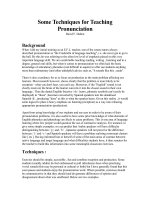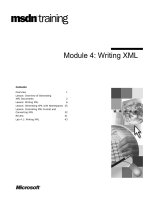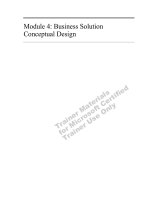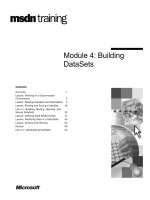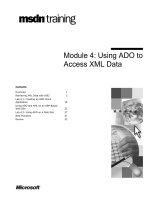Module 4 Teaching Pronunciation
Bạn đang xem bản rút gọn của tài liệu. Xem và tải ngay bản đầy đủ của tài liệu tại đây (302.29 KB, 11 trang )
Module 4
Teaching Pronunciation
Unit 1: What does teaching pronunciation
involve?
• The concept of “pronunciation” may be said to
include:
- The sounds of the language or phonology
- Stress and rhythm
- Intonation
1. Sounds
It’s useful to be able to list and define the sounds, or phonemes, of
the language by writing them down using phonetic
representations. Different books vary as to exactly which, and how
many, symbols are used; For teachers of English, the simplified,
phonemic alphabet may be helpful.
1
1
- The term “phonetics” is used to refer to transcriptions of the
sounds of all human languages which make distinctions between
sounds that may not be distinguished in a given language system.
• Sounds can be divided into two main types:
- Vowels
- Consonants
• Example: “map”- the central sound in the word “map” is a
vowel. The first and the third sound are consonants.
- “Phonemic” is used to refer to transcriptions of a particular sound
system.
The phonemic alphabet
2
2
Pronunciation Problems:
1. Poor correlation between the sounds of English and the
letters of English alphabet:
The alphabet has only 26 letters while there are about 36
commonly used sounds.
+ One sound may be represented by 2 letters:
E.g: “the” à / δ / is represented by 2 letters “th”
“ship”à / /∫/ is represented by 2 letters “sh”
+ One letter may represent 2 different sounds
E,g: “c” represents the sound /k/ in the word “cat”
And /s/ in the word ice /ais/.
+ The same sound may be represented by 2 different letters.
E.g: the sound /k/ is represented by the letter “c” and “k”
2. Difficulty in pronouncing sounds which does not exist in the
students’ language.
E.g: The consonant /δ/ in “the”, /θ/ in “thumb”
The Vowel /3:/ in “bird”
3. Confusion of similar sounds
3
3
E.g: /i:/ and /i/, /u:/ and /u/, /b/ and /p/
4. Difficulty in pronouncing consonant clusters:
E.g: /desks/, /fifθ/, /skju/
Steps for teaching and practising Sounds:
1. Say the sound alone
2. Say the sound in the context of a word
3. Get the students to repeat the sound in chorus and
individually.
4. Explain how to make the sound.
5. Contrast the sound with other similar sounds.
6. Give students some activities to practise the sound.
2. Rhythm and Stress
2.1. Rhythm
• English speech rhythm is characterized by tone-units: a word
or group of words which carries one central stressed
syllable.
4
4
• Example: The sentence: “Peter, come here,
please!” would divide into two tone-units: “Peter” and “come
here, please” with the two main stresses on the first syllable
of “Peter” and “here”.
2.2 Stress
Stress can be indicated in Writing: to write the stressed syllable in
capital letters:
Example: “PEter, come HERE, please!
* To stress a syllable or a word, say it with greater
speedy, volume, and pitch.
E.g: spurious / ’spju∂ri∂s /
I ate bread and cheese
/ ai eit ’bred ænd ’t∫i:z /
3. Intonation
- Intonation is the tone or pitch pattern on a sentence.
Intonation is an important aspect of the pronunciation of English,
often making a difference to meaning or implication.
- Intonation is very important in expressing meaning and
especially in showing our feelings
- Rising Intonation means the pitch of the voice rises [↗]
- Falling Intonation means that the pitch falls [↘]
- Fall-rise Intonation falls and then rises [↘↗]
- Rise-fall Intonation rises and then falls [↗↘]
E.g: Did he find it on the street? ↗
How did you ever escape? ↘
Do you prefer ↗milk or ↘ sugar?
I love all of you. ↘
5
5
* An appropriate stress and intonation representation for a rather
bossy-expression.
• Steps for teaching and practising stress and
intonation:
1. Give a good model of the sentence, saying it at normal speed,
making a clear difference between stressed and unstressed syllables
and using natural intonation.
2. The students are asked to practise a sentence using stress and
intonation pattern.
4. Flow of speech
It’s important also to be aware of the way different sounds, stresses
and intonations may affect one another within the flow of speech.
Unit Two: Listening to accents
The purpose of this exercise is to find out the specific
pronunciation problems of learners by actually listening to
examples and having to analyse and define them.
Inquiry: Identifying elements of foreign pronunciation
6
6
+ Stage 1: Preparing materials:
- Using audio cassettes, prepare recordings, two or three minutes in
length, of foreign accents, this can be done individually or in pairs
or groups.
+ Stage 2: Analysis:
- Listen to the recordings and try to analyse what it is about the
accents which make them “foreign”
+ Stage 3: Pooling and comparing:
- Share findings, in small groups, each recording is listened to and
participants try to identify the errors and how why they think these
occur.
+ Stage 4: Drawing conclusions.
- Discuss the findings and draw conclusions.
Unit Three: Improving learners’ pronunciation
1. The objective
The aim of pronunciation improvement is not to achieve a
perfect imitation of a native accent, but simply to get the learner to
7
7
pronounce accurately enough to be easily and comfortably
comprehensible to other speakers.
Inquire:
Why do learners make pronunciation errors?
Learners’ errors of pronunciation derive from various
sources:
1. A particular sound may not exist in the mother tongue, so that the
learner is not used forming it and therefore tends to substitute the
nearest equivalent he or she knows.
2. A sound dues exist in the mother tongue, but not as a separate,
phoneme: that is to say, the learner does not perceive it as a
distinct sound that makes a difference to meaning.
3. The learners have the actual sounds right, but have not learnt the
stress patterns of the word or group of words, or they are using an
intonation from their mother tongue which is inappropriate to the
target language. The result is a foreign-sounding accent, and
possible misunderstanding.
- Getting learners to perceive
The first thing that needs to be done is to check that the
learners can heat and identify the sounds you want to teach. The
same goes for intonation, rhythm and stress: can the learner hear
the difference between how a competent, or native, speaker of the
8
8
language says a word, phrase or sentence and how a foreign
learner says it?
Telling learners what to do
The next stage for some learners may be some find of
explicit exhortation: This is what it ought to be, this is what you are
wrong
Practicing correct pronunciation
Finally, when we are satisfied that the pronunciation point
has been perceived and learners can produce an acceptable
version we come on to the stage of practice: consolidating and
establishing the habits of acceptable pronunciation through
exercises that provide repetition and reinforcement.
Unit Four: Further topics for discussion
This unit looks at some controversial issues connected with
the teaching of pronunciation and invites you in the tasks to
examine and state your own position on them. My opinions follow
the tasks.
- Look at some suggested questions, discuss them with colleagues.
- Before beginning to work on the questions, decide:
+ Are there any you wish to omit?
+ Are there any others you wish to add?
+ Do you wish to change the order?
Decide on and perhaps note down your answers before
looking at my own answers.
9
9
Unit Five: Pronunciation and spelling
* The alphabet.
The basic sound-symbol correspondence is learned at the
stage of learning the alphabet. Every symbol needs to be taught
with its pronunciation. The learner is actually using more or less
the same alphabet but the letters represent slightly-or-very
different sounds you may have a more subtle teaching problem.
*Rules of pronunciation-spelling correspondence
Words or sets of words with unusual pronunciation or
spelling you need to teach and practice on their own - some ideas
follow at the end of unit.
* Pronunciation and spelling activities.
Some ideas that practice pronunciation - spelling
correspondence may be found in pronunciation books, such as
those listed under Further reading; books on spelling usually just
give rules, list of words and then suggest practicing through
dictation and spelling tests.
* Ideas for improving learner’s pronunciation:
10
10
- Imitation of teacher or recorded model of sounds,
words and sentences.
- Recording of learner speech, contrasted with native
model.
- Systematic explanation and instruction
- Imitation drills: ( repetition of sounds, words and
sentence.
- Choral repetition drills.
- Varied repetition drills (varied speed, volume, mood)
- Learning and performing dialogues
- Learning by heart of sentences, rhymes
- Self – correction through listening to recordings of own speech.
11
11

